John Godfrey
30 October 1825 – 19 February 1893
Thomas and Elizabeth Ainge Godfrey were of peasant stock whose families had
lived in Hanbury, Worcestershire, England for several generations.
Thomas was a farm laborer and must have had some difficulty in
supporting his family, as those were difficult times for the laborer.
Farm prices had fallen disastrously, for example, cows were worth
fifteen pounds (British currency) in 1813 but only three pounds in
1826.
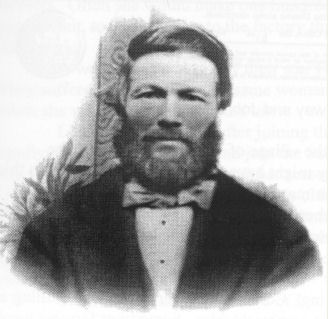
It was in these circumstances that Thomas and Elizabeth were married on August 23, 1824 in Claines, Worcestershire, England. Their first child, John was born October 30, 1825 in Hanbury, Worcestershire, England. This is his story.
John's siblings were George Ainge (21 Oct 1827), Joseph (17 Dec 1829), Ann Ainge (28 Nov 1832), Richard (11 Mar 1835), Samuel (1 Mar 1838), Sarah Jane (3 Oct 1851), and Fanny (15 Mar 1852). As John and his brothers and sisters were growing up, the circumstances of the family began to improve.
When a reform bill was passed in 1832 some quarter of a million new voters were added to the rolls and one out of six adult males now had the right to vote. More such acts were passed, extending the individual's civil rights. The poor laborer came closer to gaining his freedom, or at least that probably was his thoughts. The Godfrey's must have felt that they gained something from this Act.
The Factory Act and others during this time widened the scope of earlier legislation. No one under the age of eighteen was allowed to work for more than sixty-nine hours a week. Inspectors were allowed to enter factories at all times to see that regulations were observed. This did concern the Godfreys for all the children of the family would be sent to work at a very young age.
Bad harvests prevailed for two years and severe trade depression led to
hunger, unemployment, and general unrest, The Hungry Forties, was the
term applied to those lean years.
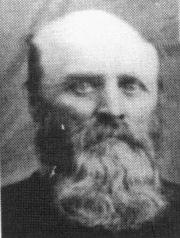
Thomas Godfrey
A grain drill was invented which planted the grain evenly in rows instead of having it broadcast haphazardly by hand as it had been done previously. By about 1825 the complete iron plow made its appearance. It would seem a good guess that John was familiar with the older type of machinery, for he would demonstrate proficiency with such machinery later in his life in Utah.
There was little room in the laborer's life for education, which probably meant farm workers must have been, at least to a degree, illiterate. It was a matter of chance whether a country child could get to school at all and if there was any compulsion it was the other way, for schooling had to take second place to earning a living.
Since the Godfreys were poor laborers it is not surprising that John would begin working at a young age. Horses played a large part on every farm. They were used for all kinds of farm work, including plowing, harrowing, and roadwork. John worked at driving horses and he drove from three to five teams at a time. He seemed to have the ability to get them to do what he wanted. It is part of the Godfrey heritage to love fine horses.
John married Mary Pittaway in the Dodderhill Parish Church on September 15, 1843. Mary Pittaway was born May 1, 1822 in Droitwich, Worcestershire, England. Her parents were John Pittaway and Ann Willis. Not much of Mary's life has been preserved as a young girl. Mary was nineteen years old when she had her first child, Letitia Pittaway. Letita was born out of wedlock on September 22, 1841. Her father was Abraham Louis.
Since John and Mary spent much of their life in the village of Wichbold, reputedly the ancestral home of the Pittaways, it seems logical that they might have met there. John worked in this community on a large farm for about four years after their marriage and it would seem to be a reasonable conclusion that he might have been working there prior to their marriage, thus being in the vicinity of the home of his future bride and giving the couple an opportunity to meet and become acquainted.
Farm laborers had one outstanding characteristic - they were all poor. The cash wage had fallen and with wages being low, so were the costs of living. Cottage rents were about one shilling a week and for this a tenant had a garden where he grew his own vegetables. Sometimes farmers would allow their help extra ground for growing potatoes. Most cottages kept a pig or chickens and some kept a rabbit. Skim milk was often available from the farm dairy at very slight cost, and the family food supply was further supplemented by grain gleaned at harvest time.
The man for whom John worked required one of his hired hands to give the text of the previous Sunday's sermon, or the entire crew went without dinner. One day, as noon approached, the boys who had not attended church the previous Sunday wondered what they were going to do. Finally they elected John to give their boss the required text. When the employer made his request John replied: “The Lord above sends down his love, sharp edged swords, and sickles, to cut the throat of all such folk, that begrudge their servants victuals.”
It is supposed that the hired hand's request for food was granted that day even though the required text had not been furnished.
Mary and John had three children when they heard the gospel from the missionaries. In addition to Letitia, their first child, George was born on January 24, 1845 in Droitwich, Worcestershire and Thomas was born on November 25, 1846 in Wychbold, Worcestershire.
John was twenty-three when he was baptized a member of The Church of Jesus
Christ of Latter-day Saints April 2, 1848 by Charles Knight, and
confirmed by Joseph Westergard. Mary was baptized September 3, 1848,
in Dodderhill by Joseph Westwood. Their son, George, was baptized
August 18, 1850, and John's mother Elizabeth Ainge Godfrey was
baptized September 28, 1850. His Father, Thomas Godfrey, was also
baptized in 1850. Many of John's brothers and sisters also joined the
church in the years that followed.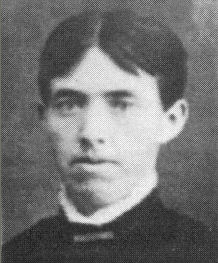
Elizabeth Ainge Godfrey
As soon as they joined the church, most of his friends and neighbors turned against him. John was baptized into his new faith on Sunday and on Monday morning his foreman asked him to report to the office at the end of the day. Opposition to the Mormon Church was very high at the time and John anticipated that he would be told that his services would be no longer required, so he was not surprised when Mr. Bladden, the farm owner, said that he understood that John had joined the Mormon Church, and gave him the choice of giving up his church, or his job.
John gave up his job, and then had to search for another one. He was unsuccessful in his first attempts because he was well known in his district, and word had been sent around that John Godfrey had joined the hated Mormons, and none of the farmers would hire him.
Since no work meant no food for his family, he went to work on the railroad where he injured his ankle and is said to have laid among strangers for some time, and then returned to his old neighborhood and worked in the salt mines. While there he served as the presiding elder in the district. While holding this position he organized two or three additional branches of the Church.
However, his former employer requested his return to work on his large farm, and was rehired. Over the next several years they had six more children: Joseph, born February 18, 1849 at Wychbold; Mary Ann on June 8, 1852; Lucy on March 10, 1853; John Ezekiel on March 10, 1854; Emma Elizabeth on April 6, 1856; and Sarah on July 22, 1859. The last five were all born in Stoke Prior, Worcestershire.
A woman wanted to buy their son Thomas, and Mary and John of course refused the offer. They suffered greatly when the same woman kidnapped their three-year-old. He was only returned when she was threatened with the law.
Like most Mormons, after joining the church, John received impressions that he and his family should leave England and join the Saints in Utah. His Brother Richard immigrated in 1856 and his sitser Ann in 1859. John was encouraged to send his oldest son George to America to prepare the way for the rest of the family to follow a year later.
Charles W. Penrose, a native of London and afterward an apostle and counselor in the first presidency of the Mormon Church, often visited the Godfrey home and made it his headquarters whenever he was in their part of England. It was probably no accident that when George immigrated, he went on the ship Monarch of the Sea in 1861 with President Penrose in charge of the group.
After George had left England John spoke in tongues in a church meeting, it frightened him, as he did not know what he was saying. A sister interpreted and said that through his faithfulness, a way would be provided and money furnished and they could go to America within a year's time. This spiritual experience was something John never forgot.
It looked for a while that it would be impossible for the rest of the
Godfreys to follow, but the way was provided. They were among some
eight hundred Mormons who left Liverpool on the sailing vessel The
William Tapscott May 14, 1862, under the leadership of Elder William
Gibson. After six weeks and three days on the ship, they landed in
New York. Mary's daughter Letitia never joined the church and
remained in England with her grandmother.
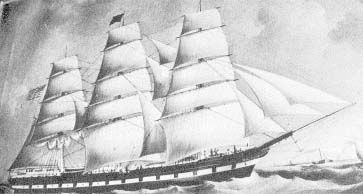
The William Topscott
The family made the trip from New York to St. Joseph, Missouri by train and from St. Joseph to Florence, Nebraska by steamboat. The family stayed at Florence from July 8th to August 10th when the journey across the plains was begun. They traveled by means of ox carts that had been previously driven from Salt Lake City to Florence. There were six hundred and sixty five persons, with a hundred wagons and eight hundred oxen; this being enough oxen to allow for four oxen per wagon, plus enough additional oxen to permit changing of the teams from time to time. John and Mary's wagon had 19 people and John walked all the way.
After they had traveled a few days they passed a Trading Post where some soldiers were stationed. The soldiers were killing a steer and because the family had always been told that in America people did not eat the head of anything, Thomas, the second son of John, asked the soldiers if they were not going to use the head if he might have it. They said, yes, and gave him a good big piece of it for soup. Every bit that could be used was used and enjoyed very much by the company.
This company was under the leadership of Henry W. Miller, who was an experienced frontiersman and had served previously as a missionary to the Indians. During the trip each night there were six men posted as guards to prevent Indians from stampeding the oxen. There were twenty-eight who died during the trip and were buried along the way.
John brought quantities of sewing needles to this country for friends in England who were sending them to others who had come earlier. He also had two buffalo robes, which was the only bedding Thomas, Joseph and John had while crossing the plains. These Mormons, who traveled form Europe to Salt Lake Valley were not left on their own entirely, but were on the contrary, very well organized. They were shepherded from their localities to the seaport where they would board ships chartered for ocean crossing. On the ships they were organized into temporary groups with experienced members taking charge.
The Godfreys arrived in Salt Lake Valley October 10, 1862, over five months after leaving their homeland. The oldest son George, who had come one year earlier, welcomed them. George had been living with John's brother, Richard and his family
George had purchased a lot and had built a one-room log cabin with furniture and had it ready for the family when they arrived. George had worked hauling gravel and rock for the Salt Lake temple and had done excavating work for the Salt Lake Theater, one of the big public works projects of the time. John and his second son, Thomas, worked that winter sawing wood to provide for the family.
Upon arriving in Salt Lake the family found themselves in debt for about $1400 and that John went to work with great determination and paid it all off, with interest.
In May of 1863 the family moved to "Chalk Creek," located to the east of the Weber River near Coalville, Utah. John ran a farm for Ira Hinckley, planting wheat, barley, and oats, crops they had raised in England. Their youngest child, Catherine was born on August 10, 1863 in Chalk Creek.
A severe frost came in late August or early September and killed their entire crop, so the family moved to Wellsville in Cache Valley, staying there only two months, then moving on to Mendon, a neighboring community. They farmed that year in Mendon on a rented farm.
After living in a dugout for the winter, the Godfreys built a log house, fourteen feet square, with a dirt roof and floor, which they traded, along with the city lot on which it stood, for a yoke of oxen when the family decided to move to Clarkston that next spring. John Godfrey went to Clarkston in the early spring of 1865 and planted a crop of grain and a garden. He is credited with being the first man in that settlement to plow the ground. In May 1865 John moved his family to Clarkston, where they camped in the open for a few weeks until he built a small house.
After moving to Clarkston, his mother and father immigrated to America and settled in Clarkston. His brother Richard also settled in Clarkston. His oldest son George and his family also moved to Clarkston. Other family members settled elsewhere in Cache Valley as well.
The year 1866 brought trouble with the Shoshone Indians. These Indians claimed all of the land west of Bear River as theirs, so they came to assert their rights. The pioneers followed counsel previously given by President Brigham Young that it was better to feed the Indians than to fight them. But their supplies dwindled and they did not have enough food to feed themselves, even without considering the Indians. The Indians finally began to kill the settlers' cows and with this they were advised to move to Smithfield, another small settlement some twelve miles to the east.
The men spent many tedious hours traveling back and forth in their efforts to gain a harvest from the crops that they had planted the previous spring. In the fall President Brigham Young came to Logan, the county seat, and told the Clarkston settlers that they could return to their homes, provided that they would build a fort to protect themselves. With that the small band proceeded to move. Joseph Godfrey, third son of John and Mary was drowned while they were crossing Bear River on the way back. He was seventeen years old and it would seem that he had his best years ahead of him. This tragedy must have been one of the most trying situations in a series of difficult ones that the Godfreys encountered.
When the settlers moved back to Clarkston they built or arranged houses
already built in such a way as to form a fort. In the fort babies
were born, children went to school, animals were cared for, meals
were cooked: In other words life went on just as it would have if
they were not living in a fort. The settlers moved to higher ground
after staying in the fort for three or four years.
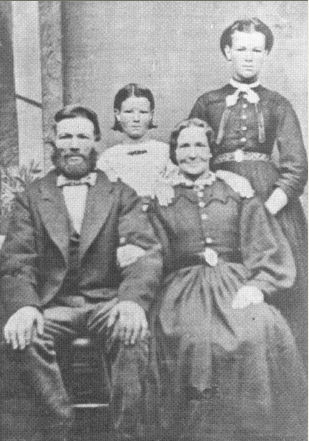
John and Mary Godfrey with their two
youngest daughters, Catherine and Sarah
sometime in the early 1870s.
John Godfrey was a good speaker and a very witty man. He must have had some musical ability for he is listed as being one of the early choristers of the Clarkston Ward. He was energetic, hopeful, and had self-confidence, which were traits of the Victorian Englishman, and which seem to be necessary attributes of a pioneer.
In keeping with this common practice and belief of his people at the time, John Godfrey had married Olina Thalseth as a plural wife, on February 14, 1876. Olina was born on January 25, 1841 in Frondhiem, Norway. Their first child, Mary Olina, was born on December 13, 1876 in Clarkston. She died in March 1877 in Clarkston.
This new arrangement was a difficult trial for Mary. They tried to live together, but it was no use. Mary asked John to take his new wife and leave. John moved with Olina to Mendon sometime in 1877. John and Mary were divorced and after John moved to Mendon, Mary and her youngest daughter, Catherine, were left to make her own way.
Four more children were born to John and Olina: Maria Elizabeth on March 4, 1878; Moses Talseth on April 11, 1879 and died on November 19, 1879; James Andrew on 10 November 1880; and Samuel Talseth on August 22, 1881. These children were all born in Mendon. In 1891, John moved this family back to Clarkston where he homesteaded more land.
John Godfrey died on February 19, 1893, age sixty seven, in Clarkston. Peter S. Barson wrote his obituary which included the following:
Brother John Godfrey was a good honest Latter-day saint. Considering his limited means he gave freely for all church purposes and we will all miss his good counsel.
The funeral services were held in the Clarkston meeting house on Tuesday 21 of Feb. The speakers were counselor Henry Yeates, counselor Andrew Heggie, David Buttars, and Brother Samuel Perkins of Wellsville.
The closing remarks were made by Bishop John Jardine. They were all personally acquainted with the deceased and bore witness to his good character. The remains were followed to the graveyard by 30 sleigh loads of relatives and friends, who turned out in mass to pay the last tribute of respect to one who was generally respected.
Mary Pittaway Godfrey passed away on June 15, 1901 at the age of seventy nine in Clarkston. Olina Talseth Godfrey died on June 5, 1914 in Salt Lake City. All three are buried in the Clarkston Cemetery.
A PATRIARCHAL BLESSING GIVEN TO JOHN GODFREY
A Patriarchal Blessing by Charles H. Hyde, upon the head of John Godfrey, son of Thomas and Elizabeth Godfrey; born 30 October 1825, in England.
John, I place my hands upon thy head and seal on thee a Patriarchal Blessing. Thou will yet be called to proclaim this gospel to nation, kindred, tongues and people. Thou shall have a voice like a trumpet and do much good in this kingdom. The spirit of the Lord shall rest upon thee and thou shall prophesy of many things. You shall hunt up the names of your dead relatives and shall do a great and mighty work for them. Thou shall be the means of bringing many souls into the kingdom of God. No power shall stay thy hands. Thine enemies shall flee before thee, some shall say that 'he' is the servant of the living God. By thy preaching kings shall bow at thy feet.
Thou art of Joseph, a right to the fullness of the Priesthood with wives and a great kingdom on the earth. Thou shalt have houses, lands, horses and chariots for thy comfort. You shall see the coming of the son of God. You shall be crowned with glory and Eternal life with thy Father's household, for ever and ever. Amen.
The source of this story comes from histories of John and Mary written by Richard S. Godfrey and Elinor Godfrey Hyde.